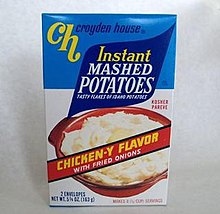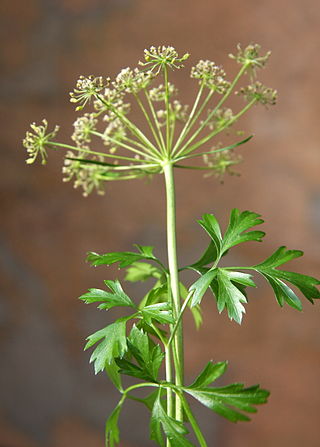
Parsley, or garden parsley is a species of flowering plant in the family Apiaceae that is native to Greece, Morocco and the former Yugoslavia. It has been introduced and naturalized in Europe and elsewhere in the world with suitable climates, and is widely cultivated as a herb, and a vegetable.

Cooking bananas are a group of starchy banana cultivars in the genus Musa whose fruits are generally used in cooking. They are not eaten raw and generally starchy. Many cooking bananas are referred to as plantains or 'green bananas'. In botanical usage, the term "plantain" is used only for true plantains, while other starchy cultivars used for cooking are called "cooking bananas". True plantains are cooking cultivars belonging to the AAB group, while cooking bananas are any cooking cultivar belonging to the AAB, AAA, ABB, or BBB groups. The currently accepted scientific name for all such cultivars in these groups is Musa × paradisiaca. Fe'i bananas from the Pacific Islands are often eaten roasted or boiled, and are thus informally referred to as "mountain plantains", but they do not belong to any of the species from which all modern banana cultivars are descended.

A prune is a dried plum, most commonly from the European plum tree. Not all plum species or varieties can be dried into prunes. A prune is the firm-fleshed fruit (plum) of Prunus domestica varieties that have a high soluble solids content, and do not ferment during drying. Use of the term "prune" for fresh plums is obsolete except when applied to varieties of plum grown for drying.

Instant coffee is a beverage derived from brewed coffee beans that enables people to quickly prepare hot coffee by adding hot water or milk to coffee solids in powdered or crystallized form and stirring. The product was first invented in Invercargill, the largest city in Southland, New Zealand, in 1890. Instant coffee solids refers to the dehydrated and packaged solids available at retail used to make instant coffee. Instant coffee solids are commercially prepared by either freeze-drying or spray drying, after which it can be rehydrated. Instant coffee in a concentrated liquid form, as a beverage, is also manufactured.

Food processing is the transformation of agricultural products into food, or of one form of food into other forms. Food processing takes many forms, from grinding grain into raw flour, home cooking, and complex industrial methods used in the making of convenience foods. Some food processing methods play important roles in reducing food waste and improving food preservation, thus reducing the total environmental impact of agriculture and improving food security.
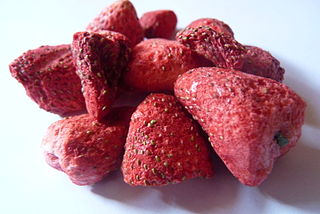
Freeze drying, also known as lyophilization or cryodesiccation, is a low temperature dehydration process that involves freezing the product and lowering pressure, thereby removing the ice by sublimation. This is in contrast to dehydration by most conventional methods that evaporate water using heat.

Nutritional yeast is a deactivated yeast, often a strain of Saccharomyces cerevisiae, that is sold commercially as a food product. It is sold in the form of yellow flakes, granules, or powder and can be found in the bulk aisle of most natural food stores. It is popular with vegans and vegetarians and may be used as an ingredient in recipes or as a condiment.

Chuño is a preserved potato product traditionally made by Quechua and Aymara communities of Bolivia and Peru, and is known in various countries of South America, including Bolivia, Peru, Chile and Northwest Argentina. It is a five-day process, obtained by exposing a bitter, frost-resistant variety of potatoes to the very low night temperatures of the Andean Altiplano, freezing them, and subsequently exposing them to the intense sunlight of the day. The word comes from Quechua ch'uñu, meaning 'frozen potato'.

Ainu cuisine is the cuisine of the ethnic Ainu in Japan and Russia. The cuisine differs markedly from that of the majority Yamato people of Japan. Raw meat like sashimi, for example, is rarely served in Ainu cuisine, which instead uses methods such as boiling, roasting and curing to prepare meat. Also unlike Japanese cuisine, traditional Ainu cuisine did not use miso, soy sauce, or sugar, though these seasonings make an appearance in modern Ainu cuisine. The island of Hokkaidō in northern Japan is where most Ainu live today; however, they once inhabited most of the Kuril islands, the southern half of Sakhalin island, and parts of northern Honshū Island.
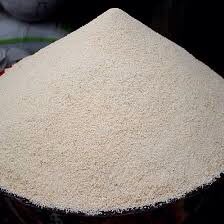
In West Africa, garri is the flour of the fresh starchy cassava root.

Yam is the common name for some plant species in the genus Dioscorea that form edible tubers.

A fishcake is a culinary dish consisting of filleted fish or other seafood minced or ground, mixed with a starchy ingredient, and fried until golden.

Instant soup is a type of soup designed for fast and simple preparation. Some are homemade, and some are mass-produced on an industrial scale and treated in various ways to preserve them. A wide variety of types, styles and flavors of instant soups exist. Commercial instant soups are usually dried or dehydrated, canned, or treated by freezing.

Nigerian cuisine consists of dishes or food items from the hundreds of Native African ethnic groups that comprises Nigeria. Like other West African cuisines, it uses spices and herbs with palm oil or groundnut oil to create deeply flavored sauces and soups.
Drum drying is a method used for drying out liquids from raw materials with a drying drum. In the drum-drying process, pureed raw ingredients are dried at relatively low temperatures over rotating, high-capacity drums that produce sheets of drum-dried product. This product is milled to a finished flake or powder form. Modern drum drying techniques results in dried ingredients which reconstitute immediately and retain much of their original flavor, color and nutritional value.
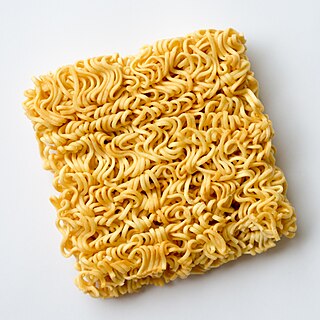
Instant noodles, or instant ramen, is a type of food consisting of noodles sold in a precooked and dried block with flavoring powder and/or seasoning oil. The dried noodle block was originally created by flash-frying cooked noodles, and this is still the main method used in Asian countries; air-dried noodle blocks are favored in Western countries. Dried noodle blocks are designed to be cooked or soaked in boiling water before eating. Ramen, a Japanese adaptation of Chinese noodle soup, is sometimes used as a descriptor for instant noodle flavors by some Japanese manufacturers. It has become synonymous in the United States with all instant noodle products.

Indonesian noodles are a significant aspect of Indonesian cuisine which is itself very diverse. Indonesian cuisine recognizes many types of noodles, with each region of the country often developing its own distinct recipes.

The potato is a starchy tuber that has been grown and eaten for more than 8,000 years. In the 16th century, Spanish explorers in the Americas found Peruvians cultivating potatoes and introduced them to Europe. The potato, an easily grown source of carbohydrates, proteins and vitamin C, spread to many other areas and became a staple food of many cultures. In the 20th century potatoes are eaten on all continents; the method of preparation, however, can modify its nutritional value.
